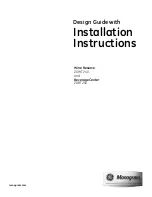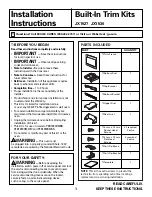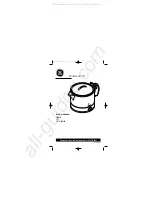
EN
EN
70
71
CARE AND CLEANING
WARNING
–
Ensure that the appliance, vacuum containers, foils and
bags are always out of reach of children younger than 8 years and animals.
Always unplug the power cord from the mains power supply, before cleaning the
appliance. Do not spill or pour any liquids on or into the appliance or power cord.
Do not immerse the appliance or any part of it in water or any other liquid. Do not
place the appliance or power cord on wet surfaces to avoid risk of electric shock.
Do not place the appliance or any part of it in an automatic dishwasher.
CAUTION
– Do not use any hard or sharp-edged objects, corrosive chemi-
cals, disinfectants, abrasive cleaners, or scouring pads for cleaning the appliance
or any part of it. Do not attempt to open the lid or foil cutter with violence. To open
the lid: press the release buttons at both sides of the appliance. To open the foil
cutter: push the cutter bar at both sides to the rear of the appliance. Do not poke
or scratch with any foreign objects in the appliance or vacuum port. Special care
is required, when cleaning the vacuum gaskets. Always ensure that liquids may
not run into the vacuum port or intake opening in the vacuum chamber.
Always grasp the plugs for connecting or disconnecting the power cord or vacuum
hose. Do not pull the cord or hose.
1. Unplug the appliance and remove the vacuum hose. Ensure to close the vacuum
port via the protection plug. This will prevent that liquids and contaminants get
into the vacuum port.
2. If required, clean the power cord and vacuum hose using a soft, slightly damp
cloth. Particles and liquids within the vacuum hose may be blown out.
IMPORTANT -
There is no way to clean the interior of the vacuum hose, if you
cannot blow out liquids or particles clogging the interior. In this case, replace the
vacuum hose by the designated spare part, recommended by the manufacturer.
Please, contact your vendor.
DO NOT rinse the vacuum hose with any type of
liquid
, because the liquid can not evaporate completely from within the vacuum
hose and would be sucked into the vacuum pump of the appliance on later use.
3. Open the lid and pull out the drip tray from the vacuum chamber. Ensure that
liquids within the drip tray are not spilled into the appliance. Wash the drip tray
in warm dishwater. Carefully, remove any residues in the vacuum chamber via
a soft damp cloth.
IMPORTANT - Do not rub on the vacuum gaskets.
Handle the foil cutter with care
to avoid damage to the hinges.
4. If required, clean the vacuum gaskets by dabbing them with a soft damp cloth.
Carefully wipe the heating bar and sealing bar with a soft cloth, moistened with
warm dishwater.
Problem
Possible Reasons
The Easy Solution
The vacuum system within
the appliance is clogged or
leaking.
Stop the evacuation immediately, when any type of
liquid or powder is sucked in.
DO NOT use the
appliance for vacuumizing any food or objects
containing alcohol or solvents!
Contact your vendor for examination and repair.
After some time of
storage, the container
or bag is filled with gas
again.
The food is not suited for
vacuum packaging.
Some types of food produce gases during storage. These
types of food are not suited for vacuum sealing.
The food has gone bad.
Perishable food produces gases, when going bad.
In
any case, discard the food!
The sealing area of the
container or bag has not
been absolutely clean
and dry.
Before vacuum sealing, ensure that the sealing areas of
the container or bag are undamaged and completely cle-
an and dry (interior and exterior).
When the food is still in perfect condition, you should
consume it in time. Some types of dry food may be vacu-
um sealed again.
The container or bag is
damaged.
When the food is still in perfect condition, you should
consume it in time. Some types of dry food may be vacu-
um sealed again.
– Clean the sealing gasket of the container. Replace the
sealing gasket, when it is brittle, scratched, broken or
worn.
– Ensure that the used bags or containers are completely
undamaged and air-tight. If in doubt, use another bag or
container.
Handle vacuumized bags and containers with care (see
also: ‘Properties of Your New Design Vacuum Sealer
Basic / Vacuum Containers’). This holds especially, when
freezing the bag or container. Protect containers and bags
from excessive mechanical or thermal stress and direct
sunlight. Do not place any heavy or sharp-edged objects
on the bags or containers, even when they are not vacu-
umized.




































